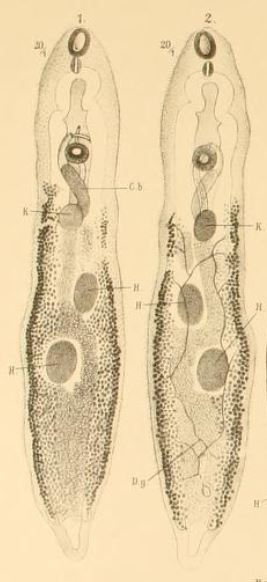Plagiorchis vespertillionis
Plagiorchis vespertilionis is a species of trematode in the family Plagiorchiidae. It is a parasitic flatworm that primarily infects bats. Like other trematodes, P. vespertilionis has a complex life cycle that involves multiple hosts, typically including aquatic snails as the first intermediate host, insects as the second intermediate host, and mammals, specifically bats, as the definitive hosts where the adult worms reside and reproduce.
Life Cycle[edit | edit source]
The life cycle of Plagiorchis vespertilionis begins when eggs are released into the environment with the feces of the infected definitive host. These eggs hatch in water, releasing miracidia, which then infect suitable aquatic snail species. Within the snail, the miracidia develop into sporocysts and then into rediae, and finally into cercariae. The cercariae leave the snail and must find and penetrate a suitable second intermediate host, typically an insect. Within this host, the cercariae encyst as metacercariae. When the infected insect is ingested by a bat, the metacercariae excyst in the bat's digestive tract, mature into adult worms, and the life cycle begins anew.
Morphology[edit | edit source]
Adult Plagiorchis vespertilionis are small, flat, leaf-shaped worms. They possess a complex digestive system starting with an oral sucker, which is used for attachment to the host's tissues, and a pharynx that leads to the intestines. The reproductive system of these trematodes is hermaphroditic, containing both male and female reproductive organs, which allows them to self-fertilize or cross-fertilize within the host.
Pathogenicity[edit | edit source]
While Plagiorchis vespertilionis is primarily of interest due to its unique life cycle and its role in the ecosystem, it can cause pathology in its bat hosts. Infections can lead to gastrointestinal disturbances and may contribute to the overall stress of the host, potentially impacting bat populations. However, the specific pathogenic effects on bats and the ecological impact of these infections require further research.
Research and Importance[edit | edit source]
Research on Plagiorchis vespertilionis contributes to our understanding of parasitic diseases in wildlife, particularly those affecting bat populations. Bats play crucial roles in ecosystems as pollinators, seed dispersers, and as a natural form of pest control. Understanding the parasites that affect bats is important for conservation efforts and for monitoring the health of bat populations. Additionally, studying the life cycles of trematodes like Plagiorchis vespertilionis can provide insights into the evolution of parasitism and host-parasite interactions.
Navigation: Wellness - Encyclopedia - Health topics - Disease Index - Drugs - World Directory - Gray's Anatomy - Keto diet - Recipes
Search WikiMD
Ad.Tired of being Overweight? Try W8MD's physician weight loss program.
Semaglutide (Ozempic / Wegovy and Tirzepatide (Mounjaro / Zepbound) available.
Advertise on WikiMD
WikiMD is not a substitute for professional medical advice. See full disclaimer.
Credits:Most images are courtesy of Wikimedia commons, and templates Wikipedia, licensed under CC BY SA or similar.Contributors: Prab R. Tumpati, MD

